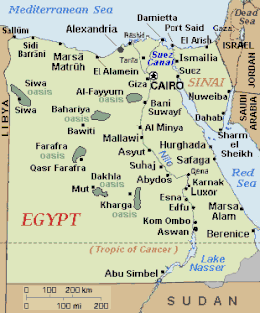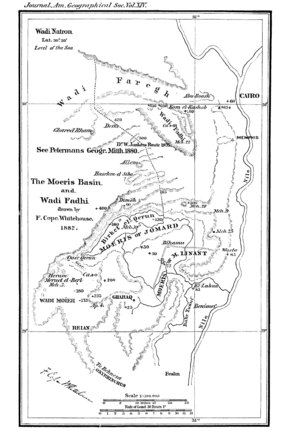Faiyum Oasis


The Faiyum Oasis (
Differing from typical
History

When the
Eventually the Nile valley bed silted up high enough to let the Nile periodically overflow into the Faiyum Hollow forming a lake. The lake is first recorded from about 3000 BC, around the time of Menes (Narmer). However, for the most part, it would only be filled with high flood waters. The lake was bordered by neolithic settlements, and the town of Crocodilopolis grew up on the south where the higher ground created a ridge.[citation needed]
In 2300 BC, the waterway from the Nile River to the natural lake was widened and deepened to make a canal which is now known as the Bahr Yussef. This canal fed into the lake. This was meant to serve three purposes: control the flooding of the Nile, regulate the water level of the Nile during dry seasons, and serve the surrounding area with irrigation. There is evidence of
Faiyum was known to the

This region has the earliest evidence for farming in Egypt, and was a center of royal pyramid and tomb-building in the Twelfth dynasty of the Middle Kingdom, and again during the rule of the Ptolemaic dynasty. Faiyum became one of the breadbaskets of the Roman world. For the first three centuries AD, the people of Faiyum and elsewhere in
"Colonial-type" village names (villages named after towns elsewhere in Egypt and places outside Egypt) show that much land was brought into cultivation in the Faiyum in the Greek and Roman periods.[8]
According to the Encyclopædia Britannica Eleventh Edition, in 1910 over 1,000 km2 (400 mile2) of the Faiyum Oasis was cultivated, the chief crops being cereals and cotton. The completion of the Aswan Low Dam ensured a supply of water, which enabled 20,000 acres (80 km2) of land, previously unirrigated and untaxed, to be brought under cultivation in the years 1903–1905. Three crops were obtained in twenty months. The province was noted for its figs, grapes, and Olives. Rose trees were numerous, and most of the attar of roses (rose oil) of Egypt was manufactured in the province. Faiyum also raised its own variety of sheep.[2]
Archaeology
In the vicinity of the lake are many ruins of ancient villages and cities. Mounds north of the city of Faiyum mark the site of Crocodilopolis/Arsinoe. Archaeological remains across the region extend from the prehistoric period to modern times, e.g. the Monastery of the Archangel Gabriel at Naqlun.
The cult of Sobek
In antiquity, the Fajyum was a center of the cult of the crocodile god Sobek. In many settlements, temples were dedicated to local manifestations of the god and associated divinities.[9] The priests of Sobek were key players in social and economic life; for example by organizing religious festivals or by purchasing goods from local producers. The development of temples dedicated to the Sobek cult can be studied particularly well in Bakchias, Narmouthis, Soknopaiou Nesos, Tebtunis, and Theadelphia, since many written sources (papyri, ostraka, inscriptions) on the daily life of the priests are available there.[10]
Egyptian temples have been operating at the edges of the Fayyum at least until the early third century and in some cases in the fourth century. The institutionalized Sobek cults existed alongside early Christian communities, which settled in the region from the third century onwards and built their first churches in the Fayyum settlements by the fourth century.[11]

Birket Qarun lake
Birket Qarun (
Cities and towns
The largest city is Faiyum, which is also the capital of the Faiyum Governorate. Other towns include Sinnuris and Tamiya to the north of Faiyum, and Sanhur and Ibsheway on the road to the lake.
In popular culture
The oasis is the setting for about a quarter of
See also
- Bahr Yussef canal
- Faiyum
- Faiyum Governorate
- Farafra
- Fayum mummy portraits
- Lake Moeris
- Monastery of the Archangel Gabriel at Naqlun
- Pedestals of Biahmu
- Phiomia (an extinct relative of the elephant, named after Faiyum)
- Roman Egypt
Notes
- ^ a b "Lake Moeris". www.brown.edu. Retrieved 2018-08-14.
- ^ a b c One or more of the preceding sentences incorporates text from a publication now in the public domain: Chisholm, Hugh, ed. (1911). "Fayum". Encyclopædia Britannica. Vol. 10 (11th ed.). Cambridge University Press. p. 219.
- ISBN 3-540-26011-0.
- S2CID 128432827.
- ^ "CATHOLIC ENCYCLOPEDIA: Egypt". www.newadvent.org. Retrieved 2023-04-30.
- Hieroglyphic writing did not have vowels, so spellings vary as to use of vowels for names in Egyptian culture. Hieroglyphic pronunciation was indicated by determinativeswhich showed what sort of meaning the word had.
- ^ "History of Encaustic Art". Archived from the original on 2012-12-23.
- ^ "Fayum Project". www.trismegistos.org. Retrieved 2023-04-30.
- ISBN 978-3-447-10810-2.
- ISBN 978-3-447-11485-1.
- )

